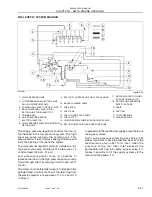
2-38
Issued 11-06
Bur
87519804 NA
CHAPTER 2 - 667TA ENGINE OVERHAUL
ENGINE REPAIR MANUAL
EDC7UC31 -ELECTRONIC CONTROL
UNIT OPERATION
ENGINE PREHEATING ELEMENT CONTROL
Pre-post heating is activated when even just one of
the water, air or fuel temperature sensors detects a
temperature of less than 5° C (41° F).
PHASE RECOGNITION
Signals transmitted by the camshaft and crankshaft
sensors determine the cylinder which fuel must be
injected.
INJECTION CONTROL
Information transmitted by the sensors, the control
unit determines and regulates pressure and modifies
the pre-injection and main injection mode.
INJECTION PRESSURE CLOSED LOOP
CONTROL
Engine load, determined by processing of data
transmitted by the various sensors, and the control
unit. Governs the regulator to maintain injection
pressure at constant optimal values.
PILOT AND MAIN INJECTION ADVANCE
CONTROL
Signals transmitted by various sensors to the control
unit, determines the optimum injection point on the
basis of internal mapping.
IDLE SPEED CONTROL
The control unit processes signals transmitted by the
various sensors and adjusts the quantity of fuel
injected.
It also controls the pressure regulator and modulates
injection duration of the electro-injectors. Within
specific limits, the control unit also monitors battery
voltage.
OVERHEATING PROTECTION
If the water temperature reaches 110° C (230° F) the
control unit reduces engine performance.
When the temperature returns below 100° C (212° F)
the engine resumes normal operation. In some
applications, the intake manifold temperature is the
reference temperature.
MAXIMUM ENGINE SPEED LIMITING
Depending on the application, the control unit
memory can contain appropriate engine speed limits.
When the engine speed surpasses these limits, the
control unit activates power reduction by controlling
tur n on time of the electro-injectors. In some
applications, the maximum limiting response consists
in stopping the engine.
CUT OFF
Fuel cut-off release is managed by the control unit
with the following logical interventions:
•
deactivation of the electro-injectors.
•
reactivation of electro-injectors immediately prior
to arrival at idle speed.
•
control of fuel pressure regulator.
SMOKE CONTROL UNDER ACCELERATION
With intense load demands, signals received from
the boost temperature pressure sensor and the
crankshaft sensor, the control unit manages the
pressure regulator and modulates the activation time
of the electro-injectors to prevent the emission of
smoke from the exhaust.
AFTER ENGINE SHUT DOWN
A f t e r t h e e n g i n e i s s t o p p e d , t h e c o n t r o l u n i t
microprocessor saves various parameters to the
EEPROM memory, including the fault log so that they
will be available the next time the engine is started.
CONTROL OF WORKING SPEED IN NORMAL
OPERATING CONDITIONS
Each time work load varies, the control unit adjusts
torque to maintain the engine in maximum power
conditions. If the load causes a reduction in power,
the control unit increases torque i.e. it increases the
amount of fuel injected in order to restore the engine
to maximum power.
Содержание 667TA/EBF
Страница 4: ...SECTION 1 ENGINE REPAIR MANUAL II Issued 11 06 Bur 87519804 NA NOTES ...
Страница 8: ...1 2 Issued 11 06 Bur 87519804 NA CHAPTER 1 DIAGNOSTICS ENGINE REPAIR MANUAL NOTES ...
Страница 16: ...1 10 Issued 11 06 Bur 87519804 NA CHAPTER 1 DIAGNOSTICS ENGINE REPAIR MANUAL NOTES ...
Страница 22: ...2 4 Issued 11 06 Bur 87519804 NA CHAPTER 2 667TA ENGINE OVERHAUL ENGINE REPAIR MANUAL NOTES ...
Страница 144: ...3 2 Issued 11 06 Bur 87519804 NA CHAPTER 3 CHARGING AND START UP ENGINE REPAIR MANUAL NOTES ...
Страница 150: ...3 8 Issued 11 06 Bur 87519804 NA CHAPTER 3 CHARGING AND START UP ENGINE REPAIR MANUAL NOTES ...
















































